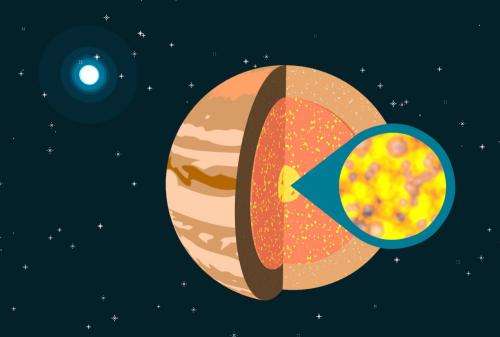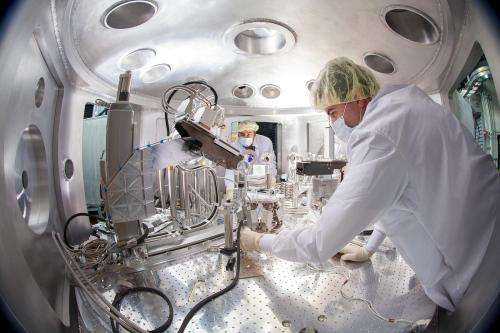Shock wave experiment provides the best look yet at 'Warm dense matter' at cores of giant planets

In an experiment at the Department of Energy's SLAC National Accelerator Laboratory, scientists precisely measured the temperature and structure of aluminum as it transitions into a superhot, highly compressed concoction known as "warm dense matter."
Warm dense matter is the stuff believed to be at the cores of giant gas planets in our solar system and some of the newly observed "exoplanets" that orbit distant suns, which can be many times more massive than Jupiter. Their otherworldly properties, which stretch our understanding of planetary formation, have excited new interest in studies of this exotic state of matter.
The results of the SLAC study, published March 23 in Nature Photonics, could also lead to a greater understanding of how to produce and control nuclear fusion, which scientists hope to harness as a new source of energy.
"The heating and compression of warm dense matter has never been measured before in a laboratory with such precise timing," says Siegfried Glenzer, a distinguished staff scientist who is part of the Stanford Institute for Materials and Energy Sciences (SIMES) at SLAC. "We have shown the detailed steps of how a solid hit by powerful lasers becomes a compressed solid and a dense plasma at the same time. This is a step on the path toward creating fusion in the lab."
A team led by Glenzer used laser light to compress ultrathin aluminum foil samples to a pressure more than 4,500 times higher than the deepest ocean depths and superheat it to 20,000 kelvins – about four times hotter than the surface of the sun. SLAC's Linac Coherent Light Source X-ray laser, a DOE Office of Science User Facility, then precisely measured the foil's properties as it transformed into warm dense matter and then into a plasma – a very hot gas of electrons and supercharged atoms.
Warm dense matter remains largely mysterious because it is difficult to create and study in a laboratory, can exhibit properties of several types of matter and occupies a middle ground between solid and plasma. Our own sun is an example of a self-sustaining plasma, and plasmas have also been harnessed in some TV displays.
While warm dense matter is believed to exist in a stable state at the heart of giant planets, in a laboratory it lasts just billionths of a second. Scientists have relied largely on computer simulations, driven by scientific theories, to help explain how a solid, when shocked with powerful lasers, transforms into a plasma.
LCLS, with its complement of high-power lasers, is uniquely suited to creating and studying matter at the extremes. Its ultrabright X-ray pulses are measured in femtoseconds, or quadrillionths of a second, so it works like an ultra-high-speed X-ray camera to illuminate and record the properties of the most fleeting phenomena in atomic-scale detail.

In this experiment, researchers used a high-power optical laser at LCLS's Matter in Extreme Conditions experimental station to fire separate beams of green laser light simultaneously at both sides of coated, ultrathin aluminum foil samples, each just half the width of an average human hair. The lasers produced shock waves in the material that converged to create extreme temperatures and pressures.
Researchers struck the samples with X-rays just nanoseconds later, and varied the arrival time of the X-rays to essentially make a series of snapshots of warm dense matter formation. The team used a technique known as small angle X-ray scattering to measure the internal structure of the material, capturing its brief transition into the warm dense state.
"This early work with aluminum is a first stepping stone toward other problems we really need to solve," Glenzer said, such as how hydrogen behaves under similar conditions. Hydrogen, which makes up about 75 percent of the visible mass of the universe, plays a central role in fusion, the process that powers stars. A better understanding of how hydrogen transitions into warm dense matter could help settle debates over conflicting theories on this transition and help unlock the secrets of fusion energy.
"I think LCLS can help to resolve the hydrogen 'controversy,' in upcoming experiments," Glenzer said.
More information: L.B. Fletcher, et al. Nature Photonics, 23 March 2015 ( DOI: 10.1038/nphoton.2015.41 ). www.nature.com/nphoton/journal … nphoton.2015.41.html
Journal information: Nature Photonics
Provided by SLAC National Accelerator Laboratory



















